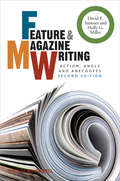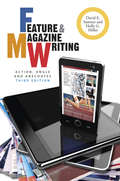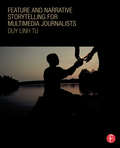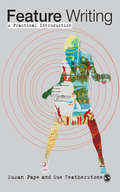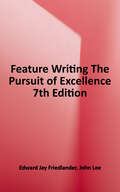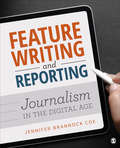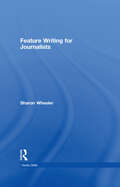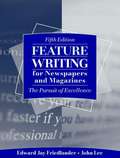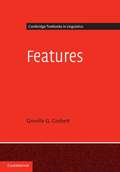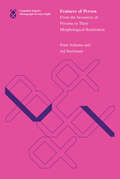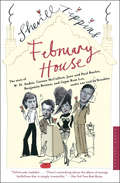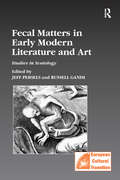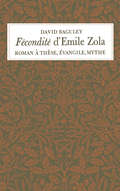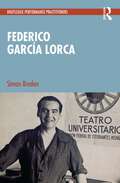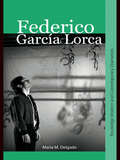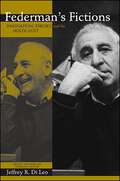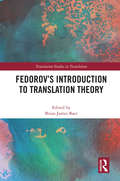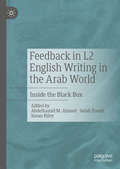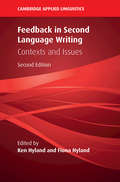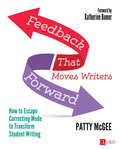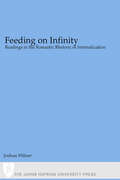- Table View
- List View
Feature and Magazine Writing
by Holly G. Miller David E. SumnerUpdated with fresh facts, examples and illustrations, along with two new chapters on digital media and blogs this third edition continues to be the authoritative and essential guide to writing engaging and marketable feature stories.Covers everything from finding original ideas and angles to locating expert sourcesExpanded edition with new chapters on storytelling for digital media and building a story blogCaptivating style exemplifies the authors' expert guidance, combining academic authority with professional know-howComprehensive coverage of all the angles, including marketing written work and finding jobs in the publishing industryEssential reading for anyone wishing to become a strong feature writerAccompanied by a website with a wealth of resources including PowerPoint presentations, handouts, and Q&As that will be available upon publication: www.wiley.com/go/sumnerandmiller
Feature and Magazine Writing: Action, Angle, and Anecdotes
by David E. Sumner Holly G. MillerUpdated with fresh facts, examples and illustrations, along with two new chapters on digital media and blogs this third edition continues to be the authoritative and essential guide to writing engaging and marketable feature stories. Covers everything from finding original ideas and angles to locating expert sources Expanded edition with new chapters on storytelling for digital media and building a story blog Captivating style exemplifies the authors’ expert guidance, combining academic authority with professional know-how Comprehensive coverage of all the angles, including marketing written work and finding jobs in the publishing industry Essential reading for anyone wishing to become a strong feature writer Accompanied by a website with a wealth of resources including PowerPoint presentations, handouts, and Q&As that will be available upon publication: www.wiley.com/go/sumnerandmiller
Feature and Narrative Storytelling for Multimedia Journalists
by Duy Linh TuFeature and Narrative Storytelling for Multimedia Journalists is the first text that truly focuses on the multimedia and documentary production techniques required by professional journalists. Video and audio production methods are covered in rich detail, but more importantly, various storytelling techniques are explored in depth. Likewise, author Duy Linh Tu tackles the latest topics in multimedia storytelling, including mobile reporting, producing, and publishing, while also offering best practices for using social media to help promote finished products. Whether you're a student, a professional seeking new techniques, or simply looking to update your skills for the new digital newsroom, this book will provide you with the information and tools you need to succeed as a professional journalist. Integrated: The lessons in this book deftly combine traditional media production principles with storytelling craft. It is written with the perspective of modern professional journalists in mind. Practical: While rich with theory, this text is based on the real-world work of the author and several of his colleagues. It features Q&As with some of the best editors and video producers from top publications, including NPR, Vice, and Detroit Free Press, as well as profiles of leading video news organizations such as Frontline, Mediastorm, and Seattle Times. Proven: The author uses pedagogy from the world-renowned Columbia Journalism School as well as case studies from his own award-winning work. Interactive: The text is exercise- and drill-based, and the companion website provides multimedia examples and lesson files, as well as tutorials, case studies, and video interviews.
Feature Writing: A Practical Introduction
by Susan Featherstone Susan PapeThis book provides a practical and richly informative introduction to feature writing and the broader context in which features journalists operate. As well as covering the key elements and distinctive features that constitute good feature writing, the book also offers a rich resource of real life examples, case studies and exercises. The authors have drawn on their considerable shared experience to provide a solid and engaging grounding in the principles and practice of feature writing. The textbook will explore the possibilities of feature writing, including essential basics, such as: Why journalists become feature writers The difference between news stories and features What features need to contain How to write features The different types of features The text is intended for both those who are studying the media at degree level and those who are wishing to embark on a career in the print industry. It will be invaluable for trainee feature writers.
Feature Writing: The Pursuit of Excellence
by Edward Jay Friedlander John LeeUsing experience-driven advice and compelling articles from scores of newspaper, magazine and online writers, Feature Writing shows how award-winning journalists achieve excellence and national recognition. The Seventh Edition helps the reader cultivate vital journalistic skills through detailed coverage on creating and refining article ideas, conducting research and interviews, writing, and navigating legal and ethical questions. World-class writing examples from Pulitzer Prize feature writers, extensive updates, and timely tips from some of America's best feature writers have made this the premier book in its field for more than three decades.
Feature Writing and Reporting: Journalism in the Digital Age
by Jennifer Brannock CoxThis new text offers a fresh look at feature writing and reporting in the 21st century. Award-winning professor and author Jennifer Brannock Cox teaches students the fundamentals of feature writing and reporting while emphasizing the skills and tools needed to be successful in the digital era. Packed with the best samples of feature writing today, this practical text gives students ample opportunity to practice their writing as they build a portfolio of work for their future careers. Cox′s special attention on new multimedia and online reporting prepares readers for success in a rapidly changing media landscape.
Feature Writing and Reporting: Journalism in the Digital Age
by Jennifer Brannock CoxThis new text offers a fresh look at feature writing and reporting in the 21st century. Award-winning professor and author Jennifer Brannock Cox teaches students the fundamentals of feature writing and reporting while emphasizing the skills and tools needed to be successful in the digital era. Packed with the best samples of feature writing today, this practical text gives students ample opportunity to practice their writing as they build a portfolio of work for their future careers. Cox′s special attention on new multimedia and online reporting prepares readers for success in a rapidly changing media landscape.
Feature Writing for Journalists (Media Skills)
by Sharon WheelerFeature Writing for Journalists considers both newspapers and magazines and helps the new or aspiring journalist to become a successful feature writer. Using examples from a wide range of papers, specialist and trade magazines and 'alternative' publications, Sharon Wheeler considers the different types of material that come under the term 'feature' including human interest pieces, restaurant reviews and advice columns. With relevant case studies as well as interviews with practitioners, Feature Writing for Journalists is exactly what you need to understand and create exciting and informative features.
Feature Writing for Newspapers and Magazines (5th edition)
by Edward Jay Friedlander John LeeUsing experience-driven advice and compelling articles from scores of newspapers and magazines, Feature Writing for Newspapers and Magazines shows how award-winning journalists achieve excellence and national recognition. Feature Writing for Newspapers and Magazines' world-class writing examples, extensive updates and timely tips from some of America's best feature and magazine writer's have made it the premier text in its field for almost two decades. The book considers such topics as: what to do about common writing problems, how to develop, research, write about and sell ideas to periodicals, and how to negotiate writing contracts and write articles so that the journalist will not get into legal trouble.
Features
by Greville G. CorbettFeatures are a central concept in linguistic analysis. They are the basic building blocks of linguistic units, such as words. For many linguists they offer the most revealing way to explore the nature of language. Familiar features are Number (singular, plural, dual, ...), Person (1st, 2nd, 3rd) and Tense (present, past, ...). Features have a major role in contemporary linguistics, from the most abstract theorizing to the most applied computational applications, yet little is firmly established about their status. They are used, but are little discussed and poorly understood. In this unique work, Corbett brings together two lines of research: how features vary between languages and how they work. As a result, the book is of great value to the broad range of perspectives of those who are interested in language.
Features of Person: From the Inventory of Persons to Their Morphological Realization (Linguistic Inquiry Monographs #78)
by Peter Ackema Ad NeelemanA proposal that person features do not have inherent content but are used to navigate a “person space” at the heart of every pronominal expression.This book offers a significant reconceptualization of the person system in natural language. The authors, leading scholars in syntax and its interfaces, propose that person features do not have inherent content but are used to navigate a “person space” at the heart of every pronominal expression. They map the journey of person features in grammar, from semantics through syntax to the system of morphological realization. Such an in-depth cross-modular study allows the development of a theory in which assumptions made about the behavior of a given feature in one module bear on possible assumptions about its behavior in other modules. The authors' new theory of person, built on a sparse set of two privative person features, delivers a typologically adequate inventory of persons; captures the semantics of personal pronouns, impersonal pronouns, and R-expressions; accounts for aspects of their syntactic behavior; and explains patterns of person-related syncretism in the realization of pronouns and inflectional endings. The authors discuss numerous observations from the literature, defend a number of theoretical choices that are either new or not generally accepted, and present novel empirical findings regarding phenomena as different as honorifics, number marking, and unagreement.
February House: The Story of W. H. Auden, Carson McCullers, Jane and Paul Bowles, Benjamin Britten, and Gypsy Rose Lee, Under One Roof in Brooklyn
by Sherill TippinsAn &“irresistible&” account of a little-known literary salon and creative commune in 1940s Brooklyn (The Washington Post Book World). A San Francisco Chronicle Best Book of the Year February House is the true story of an extraordinary experiment in communal living, one involving young but already iconic writers—and America&’s best-known burlesque performer—in a house at 7 Middagh Street in Brooklyn. It was a fevered yearlong party, fueled by the appetites of youth and a shared sense of urgency to take action as artists in the months before the country entered World War II. In spite of the sheer intensity of life at 7 Middagh, the house was for its residents a creative crucible. Carson McCullers&’s two masterpieces, The Member of the Wedding and The Ballad of the Sad Cafe, were born, bibulously, in Brooklyn. Gypsy Rose Lee, workmanlike by day, party girl by night, wrote her book The G-String Murders in her Middagh Street bedroom. W. H. Auden—who, along with Benjamin Britten, was being excoriated back in England for absenting himself from the war—presided over the house like a peevish auntie, collecting rent money and dispensing romantic advice. And yet all the while, he was composing some of the most important work of his career. Enlivened by primary sources and an unforgettable story, this tale of daily life at the most fertile and improbable live-in salon of the twentieth century comes from the acclaimed author of Inside the Dream Palace: The Life and Times of New York&’s Legendary Chelsea Hotel. &“Brimming with information . . . The personalities she depicts [are] indelibly drawn.&” —Los Angeles Times Book Review &“Magnificent . . . Not to mention funny and raunchy.&” —The Seattle Times
Fecal Matters in Early Modern Literature and Art: Studies in Scatology (Studies in European Cultural Transition #21)
by Jeff Persels and Russell GanimFeces, urine, flatus, phlegm, vomitus - unlike ourselves, our most educated forebears did not disdain these functions, and, further, they employed scatological references in all manner of works. This collection of essays was provoked by what its editors considered to be a curious lacuna: the relative academic neglect of the copious and ubiquitous scatological rhetoric of Early Modern Europe, here broadly defined as the representation of the process and product of elimination of the body's waste products. The contributors to this volume examine the many forms and functions of scatology as literary and artistic trope, and reconsider this last taboo in the context of Early Modern European expression. They address unflinchingly both the objective reality of the scatological as part and parcel of material culture - inescapably a much larger part, a much heavier parcel then than now - and the subjective experience of that reality among contemporaries.
Fecondite d'Emile Zola
by David BaguleyThis historical and critical study of Zola's Fécondité contributes much to an understanding of how the novel came to be written and of its achievements. Like Travail and Verité, the later books in the series Les Quatre Evangiles, Fécondité has not previously received significant critical attention. This study reveals and interprets the less obvious aspects of the work, its biblical and mythical themes, its sources and genesis. It also adds to our knowledge of Zola's later works through the examination of various ideological currents--particularly the impact of Malthusianism, its proponents and adversaries, and who among them Zola read in preparing this book. Fécondité deals with the particular problem of France's declining birth-rate at the end of the nineteenth century and, more generally, with the problem of decadence and cultural renewal. By the time that he wrote Fécondité, Zola had abandoned his naturalist aesthetic of scientific objectivity, if not also his working methods as a novelist. This study shoes how his didactic concerns continually asserted themselves in the structure and the use of rhetorical techniques in Fécondité. Specialists in Zola, and others more generally interested in the French culture of the late nineteenth century, as well as the particular demographic problems that Zola treats in the work, and the relationship of literature to primitive mythology, should find this study of particular interest.
Federico Fellini
by Hava AldoubyFederico Fellini professed a desire to create "an entire film made of immobile pictures." In this study, Hava Aldouby uses this quotation as a launching point to analyze Fellini's films as sequences of "pictures" that draw extensively on art history, and particularly painting, as a reservoir of visual imagery. Aldouby employs an innovative pictorial approach that allows her to uncover a wealth of visual evocations overlooked by Fellini scholars over the years.Federico Fellini: Painting in Film, Painting on Film sheds light on the intertextual links between Fellini's films and the works of various artists, from Velazquez to Francis Bacon, by identifying references to specific paintings in his films. Using new archival evidence from Fellini's private library, brought to light for the first time here, Aldouby draws out Fellini's in-depth knowledge of art history and his systematic employment of art-historical allusions.
Federico García Lorca (Routledge Performance Practitioners)
by Simon BredenLauded as one of the most important poets and playwrights of the twentieth century, Federico García Lorca was also an accomplished theatre director with a clear process and philosophy of how drama should be staged. Directing both his own work and that of others, Lorca was also closely involved in the rehearsals for productions of many of his plays, and from his own writings and those of his collaborators, a determined agenda to stimulate audiences and renovate theatre can be seen.This is the first book in English to fully consider Lorca as a director and his rehearsal methodology. The book combines:- A biographical account of Lorca’s work as a director and rehearsal leader, revealing his techniques and methods of approach texts;- An exploration of his key writings on and around theatre, drawing on his talks, play introductions, and some of the dramatic works themselves;- The first translation into English of his fragment Dragón;- A detailed discussion of Lorca’s key productions, Lope de Vega’s Fuente Ovejuna (1933) for La Barraca, and his own Yerma (1934).- Specific focus on the practical applications that we can draw from Lorca’s methods, both from what survives of his own work and from the accounts of his close collaborators.As a first step towards critical understanding, and as an initial exploration before going on to further, primary research, Routledge Performance Practitioners offer unbeatable value for today’s student.
Federico García Lorca (Routledge Modern and Contemporary Dramatists)
by Maria M. DelgadoImmortalized in death by The Clash, Pablo Neruda, Salvador Dalí, Dmitri Shostakovich and Lindsay Kemp, Federico García Lorca's spectre haunts both contemporary Spain and the cultural landscape beyond. This study offers a fresh examination of one of the Spanish language’s most resonant voices; exploring how the very factors which led to his emergence as a cultural icon also shaped his dramatic output. The works themselves are also awarded the space that they deserve, combining performance histories with incisive textual analysis to restate Lorca’s presence as a playwright of extraordinary vision, in works such as: Blood Wedding The Public The House of Bernarda Alba Yerma. Federico García Lorca is an invaluable new resource for those seeking to understand this complex and multifaceted figure: artist, playwright, director, poet, martyr and in the eyes of many, Spain’s ‘national dramatist’.
Federman's Fictions: Innovation, Theory, and the Holocaust
by Charles Bernstein Raymond FedermanThis collection of essays offers an authoritative examination and appraisal of the French-American novelist Raymond Federman's many contributions to humanities scholarship, including Holocaust studies, Beckett studies, translation studies, experimental fiction, postmodernism, and autobiography. Although known primarily as a novelist, Federman (1928–2009) is also the author of numerous books of poetry, essays, translations, and criticism. After emigrating to the United States in 1942 and receiving a Ph.D. in comparative literature at UCLA in 1957, he held professorships in the University at Buffalo's departments of French and English from 1964 to 1999. Together with Steve Katz and Ronald Sukenick, he was one of the original founders of the Fiction Collective, a nonprofit publishing house dedicated to avant garde, experimental prose. Far too many accounts treat Federman as merely a member of a small group of writers who pioneered "metafictional" or "postmodern" American literature. Federman's Fiction will introduce (or, for some, reintroduce) to the broader scholarly community a creative and daring thinker whose work is significant not just to considerations of the development of innovative fiction, but to a number of other distinct disciplines and emerging critical discourses.
Fedorov's Introduction to Translation Theory (Translation Studies in Translation)
by Brian James BaerThis is the first English translation of Andrei V. Fedorov’s classic 1953 text Vvedenie v teoriiu perevoda / Introduction to Translation Theory. Fedorov was the first to argue that translation theorizing should be based on linguistics, due to the fact that language is the common denominator of all translation. In addition, this text offers a concise but thorough comparative overview of thinking on translation in Western Europe and Russia. The detailed annotations and substantial introduction by the leading scholar and award-winning translator Brian James Baer inscribe Fedorov’s work in the political and cultural context of the Soviet Union, highlighting the early influence of Russian Formalism on Fedorov’s thinking. This volume is a model of scholarly translation that fills a major gap in our understanding of Soviet translation theory, which will compel a rethinking of current histories of the field. Contributing to the important work of internationalizing and generating new histories of translation studies, this volume is key reading for scholars and researchers of the history, theory, and politics of translation studies; comparative literature; and Russian and Slavic studies.
Feedback in L2 English Writing in the Arab World: Inside the Black Box
by Susan Riley Abdelhamid M. Ahmed Salah TroudiThis edited book uses case studies to offer a comprehensive picture of the feedback practices and perceptions pertinent to English as a Foreign Language (EFL) writing in the Arab world. It highlights essential themes about feedback in L2 writing in eight Arab countries, and offers a detailed critical analysis of feedback practices and perceptions in six of these: Egypt, Morocco, Oman, Saudi Arabia, Tunisia and the United Arab Emirates. The book will appeal to an international readership of academics, researchers and practitioners interested in EFL writing in the Arab world.
Feedback in Second Language Writing: Contexts and Issues (Cambridge Applied Linguistics)
by Ken Hyland Fiona HylandNow in its second edition, this volume provides an up to date, accessible, yet authoritative introduction to feedback on second language writing for upper undergraduate and postgraduate students, teachers and researchers in TESOL, applied linguistics, composition studies and English for academic purposes (EAP). Chapters written by leading experts emphasise the potential that feedback has for helping to create a supportive teaching environment, for conveying and modelling ideas about good writing, for developing the ways students talk about writing, and for mediating the relationship between students' wider cultural and social worlds and their growing familiarity with new literacy practices. In addition to updated chapters from the first edition, this edition includes new chapters which focus on new and developing areas of feedback research including student engagement and participation with feedback, the links between SLA and feedback research, automated computer feedback and the use by students of internet resources and social media as feedback resources.
Feedback That Moves Writers Forward: How to Escape Correcting Mode to Transform Student Writing (Corwin Literacy)
by Patty McGee"Patty McGee should be called the ′Writer Whisperer.′ She offers brilliant advice for helping struggling writers, accomplished writers, and all those in between." —Debbie Silver, Co-author of Teaching Kids to Thrive The number one challenge of student writers today isn’t word choice, logic, voice, or even grammar and spelling—it’s buy-in. In Feedback That Moves Writers Forward, Patty McGee shares how to’s for teaching that changes the writing-as-obligation vibe for good. She demonstrates the way feedback can inspire students to reach new heights as writers. With Patty’s help, you learn to: Resign from your position as Corrector-in-Chief and be amazed as students eagerly take over responsibility for refining their writing Apply the research on growth mindset and goal setting, whether you use a writing program or a workshop model Use tone, trust, and language to quicken students’ discovery of their writing identities and take risks when they are stuck Use student work to deliver clear, just-in-time feedback during planning, drafting, revising, and editing Use the online printable forms for delivering customized feedback with just the right wording Balance grading and feedback Help writers reflect so they are better able to apply what they learned about content, craft, and style to their future writing One of the bravest things we can do as teachers is to admit when a long held practice isn’t working. Error-focused feedback is one such practice. So put down the red pen, pick up this book, and learn to say the right thing at the right time to develop fearless, original, and intentional writers—in any content area.
Feedback That Moves Writers Forward: How to Escape Correcting Mode to Transform Student Writing (Corwin Literacy)
by Patty McGee"Patty McGee should be called the ′Writer Whisperer.′ She offers brilliant advice for helping struggling writers, accomplished writers, and all those in between." —Debbie Silver, Co-author of Teaching Kids to Thrive The number one challenge of student writers today isn’t word choice, logic, voice, or even grammar and spelling—it’s buy-in. In Feedback That Moves Writers Forward, Patty McGee shares how to’s for teaching that changes the writing-as-obligation vibe for good. She demonstrates the way feedback can inspire students to reach new heights as writers. With Patty’s help, you learn to: Resign from your position as Corrector-in-Chief and be amazed as students eagerly take over responsibility for refining their writing Apply the research on growth mindset and goal setting, whether you use a writing program or a workshop model Use tone, trust, and language to quicken students’ discovery of their writing identities and take risks when they are stuck Use student work to deliver clear, just-in-time feedback during planning, drafting, revising, and editing Use the online printable forms for delivering customized feedback with just the right wording Balance grading and feedback Help writers reflect so they are better able to apply what they learned about content, craft, and style to their future writing One of the bravest things we can do as teachers is to admit when a long held practice isn’t working. Error-focused feedback is one such practice. So put down the red pen, pick up this book, and learn to say the right thing at the right time to develop fearless, original, and intentional writers—in any content area.
Feeding Frenzy: Attack Journalism and American Politics
by Larry J. SabatoThe author presents the phenomenon of "attack journalism." In describing "attack journalism," he exposes the harm done by the media to politicians and the harm done to the journalistic profession itself. The author examines the origins of feeding frenzies and gives lessons and possible remedies.
Feeding on Infinity: Readings in the Romantic Rhetoric of Internalization
by Joshua WilnerWhat "internalization" means for writers and critics of Romanticism, including Rousseau, Wordsworth, De Quincey, Baudelaire, Freud, Benjamin, and SedgwickWinner of the American Conference on Romanticism's Jean Pierre Barricelli Book Prize"Although defining Romanticism is a standing problem for literary history, some notion of internalization at the level of cultural tradition has recurrently been proposed as the solution to that problem... In this debate the notion of internalization tends to be handled... as a known quantity, whereas I am arguing that the notion itself remains obscure and thus that the problem of internalization and the problem of Romanticism may indeed, with respect to the discourse of literary history, be closely intertwined"—from Feeding on InfinityNotions of "internalization" play an important role in many contemporary fields of discourse, including literary history and theory, psychoanalysis, ideological critique, and learning theory in the social sciences. Indeed, the term "internalization" is pervasive and seems to answer a shared need of expression to such an extent that it is one of those technical words that has found its way into everyday use. But the meaning of this term and the continuities and discontinuities at work in its varied deployment have, for the most part, gone unanalyzed.In Feeding on Infinity, Joshua Wilner explores the power and limits of the discourse of internalization through the close reading of a variety of texts drawn from the Romantic tradition, a tradition which is both source for and oftentimes object of this discourse. Through the study of writers including Rousseau, Wordsworth, De Quincey, Baudelaire, Freud, Benjamin, and Sedgwick, he seeks to deepen our understanding of the problem of internalization, while situating its more or less explicit emergence as a problem in relation to the history of, in Gertrude Stein's phrase, "patriarchal poetics."Through patient attention to the transformations of rhetorical structures of representation and address performed by these works and to the frequent condensation of these transformations in figures of eating and drinking, Feeding on Infinity makes available to inquiry a surprisingly rich and largely unexplored network of connections within the "long" Romantic tradition. At the same time, it forges new links between deconstructive reading practices, psychoanalysis, and recent work in gender studies.
